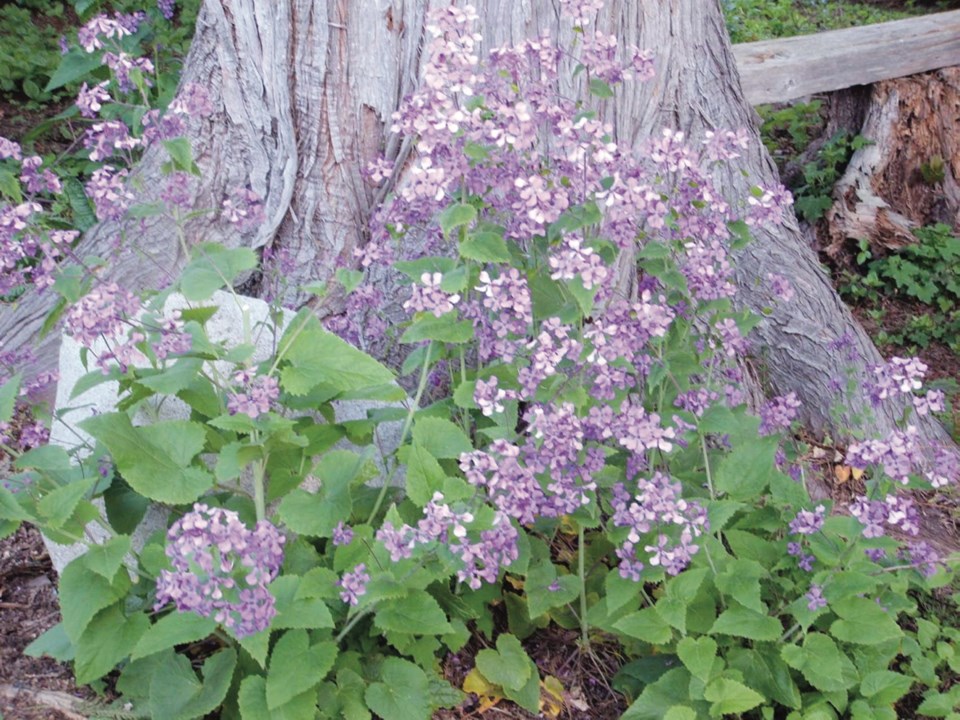Dear Helen: What is “honesty”?
D.L.
That’s a deep question, but I expect you’re not after a philosophical treatise in reply. Horticulturally speaking, “honesty” is “money plant,” an heirloom flower grown for its clusters of bright purple flowers in spring and the round, papery seed pods that follow. Stems bearing the pods are popular in dried flower arrangements.
The pods are very thin and almost transparent. Patches of the plants come up every year in a clearing behind my garden shed. I’ve noticed the pods beautifully illuminated in fall and winter sunshine.
The botanical name for money plant is Lunaria, derived from the Latin “luna,” meaning the moon — which is round and silvery, like the seed pods.
Lunaria is a biennial, like foxglove. Seeds fall out of the dried pods, germinate, and form rosettes of foliage that remain over the winter, to send up flowering stems in the spring.
The complete botanical name is Lunaria annua, though the plants are not annuals. The “annua” may refer to the fact that, once the plant is established in a garden, there will be flowers year after year because the plants self-sow prolifically.
Dear Helen: Can you identify a plant that I first noticed in my garden last month? It has dark green, shiny, elongated leaves and pretty little yellow, bell-shaped flowers. I hope the photo I’ve sent helps.
R.B.
The photo pictures Daphne laureola (spurge laurel), a plant that has “escaped” from gardens to become invasive on Vancouver Island and the Gulf Islands. The Invasive Species Council of B.C. has detailed information on their website: bcinvasives.ca.
Spurge laurel grows almost anywhere and is notorious for taking over natural vegetation. It is important to prevent it from spreading. As I’ve been cleaning up wooded areas of my garden, I’ve found several plants, in bloom starting last month, that I’ve pulled up and dug out.
Daphne laureola is an evergreen shrub that is classed as poisonous as well as invasive. The bark, sap and berries are all toxic. The sap is caustic, and a significant skin irritant.
As with holly, the berries are not toxic to birds, who feed on and disperse the seeds.
Dear Helen: Last year my plum and apple trees were impacted by the winter moth.
I was dealing with illness in the family at the time and was unable to deal with the problem. What can I do now to control these insects?
O.C.
Winter moth larvae feed on flowers, leaves and buds from early April to late May or mid-June. Then they pupate in leaf littler beneath the trees, and emerge in the fall as adult moths to mate and lay eggs in the trees. That is the best time to initiate control measures.
Because the female moths are flightless and must climb up the tree trunks to lay eggs, they can be trapped by wrapping the trunk with a 25-cm wide band of plastic wrap or parcel tape and applying an insect glue such as Tanglefoot on it. Do this at mid-October, and remove the band in February.
In the fall, when you band the trees, place the bands high enough on trunks to ensure they won’t be disturbed by pets or children.
If a trunk is deeply creviced, wrap it with cotton batting before applying the outer wrap. This will keep the female moths from crawling under the sticky band.
Check the bands regularly and replace them if they become covered in debris or trapped moths.
Meanwhile, spraying with Bacillus thuringiensis kurstaki (BTK) in the spring, when the caterpillars are still small and feeding actively, will give some control if the spray is thoroughly applied.
GARDEN EVENTS
Floral art. The Mid Island Floral Art Club will meet on Thursday, March 12, at 2 p.m. in St. Stephen’s Church Hall, 150 Village Way in Qualicum Beach. Theme for the afternoon: Have a Go at Midollino Magic. Information at 250-752-1858.
Seedy in Cobble Hill. Meet at the Cobble Hill Community Hall, 3550 Watson Ave., between 10 a.m. and 2 p.m. on March 14 for the community’s much expanded 20th Seedy Saturday. There will be vendors to meet all gardening needs, an exchange of saved seeds and local food. Admission is free.
Nanaimo meeting. The Nanaimo Horticultural Society will meet on Saturday, March 14, at 1 p.m. in First Unitarian Fellowship Hall, 595 Townsite Rd. The afternoon will feature Colin Bartlett speaking about backyard birds and a judged parlour show. Information at 250-758-6783.



